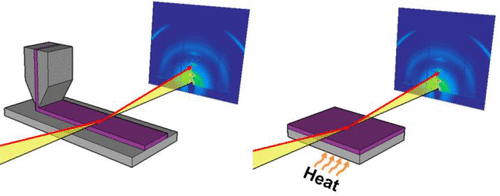当前位置:
X-MOL 学术
›
Macromolecules
›
论文详情
Our official English website, www.x-mol.net, welcomes your feedback! (Note: you will need to create a separate account there.)
Enhancing Optoelectronic Properties of Conjugated Block Copolymers through Crystallization of Both Blocks
Macromolecules ( IF 5.5 ) Pub Date : 2020-03-10 , DOI: 10.1021/acs.macromol.9b01947 Thinh P. Le 1 , Brandon H. Smith 1 , Youngmin Lee 1 , Joshua H. Litofsky 1 , Melissa P. Aplan 1 , Brooke Kuei 2 , Chenhui Zhu 3 , Cheng Wang 3 , Alexander Hexemer 3 , Enrique D. Gomez 1, 2
Macromolecules ( IF 5.5 ) Pub Date : 2020-03-10 , DOI: 10.1021/acs.macromol.9b01947 Thinh P. Le 1 , Brandon H. Smith 1 , Youngmin Lee 1 , Joshua H. Litofsky 1 , Melissa P. Aplan 1 , Brooke Kuei 2 , Chenhui Zhu 3 , Cheng Wang 3 , Alexander Hexemer 3 , Enrique D. Gomez 1, 2
Affiliation

|
Microphase-separated block copolymers composed of electron donor and acceptor blocks may provide morphology control to address many challenges in organic electronics. Crucial to controlling the self-assembly of fully conjugated block copolymers is tuning the interplay between crystallization of the individual blocks and microphase separation between the donor and the acceptor. Thus, we have examined the kinetics of the morphological evolution in P3HT-b-PFTBT block copolymer films during two processes: solution casting and thermal annealing. We use in situ wide-angle and small-angle grazing incidence X-ray scattering to monitor the crystallization of P3HT and microphase separation between the two blocks. We find that during film drying, initial P3HT crystallization happens quickly, before phase separation of the two blocks. However, crystallization is significantly suppressed with respect to neat materials, enabling microphase separation to proceed at time scales after some initial crystallization of the donor block takes place. This enables a mesoscale structure to develop during processes such as thermal annealing because self-assembly of the lamellar structure takes place before the crystallization of the donor block is complete. We also find that significant crystallization of PFTBT blocks after P3HT crystallization is possible at elevated temperatures. Crystallization of both blocks is important to maximize the performance of solar cells and transistors with block copolymer active layers. As a consequence, we exceed 3% average power conversion efficiencies in P3HT-b-PFTBT photovoltaic devices.
中文翻译:

通过两个嵌段的结晶增强共轭嵌段共聚物的光电性能
由电子给体和受体嵌段组成的微相分离的嵌段共聚物可以提供形态控制,以解决有机电子学中的许多挑战。控制完全共轭的嵌段共聚物的自组装至关重要的是调节单个嵌段的结晶与供体与受体之间的微相分离之间的相互作用。因此,我们研究了P3HT- b形态演化的动力学-PFTBT嵌段共聚物薄膜在两个过程中:溶液流延和热退火。我们使用原位广角和小角掠入射X射线散射来监测P3HT的结晶和两个模块之间的微相分离。我们发现,在膜干燥过程中,最初的P3HT结晶会很快发生,这是两个嵌段相分离之前的结果。然而,相对于纯净的材料而言,结晶得到了显着的抑制,使得在供体嵌段的一些初始结晶发生之后,微相分离能够在一定的时间尺度上进行。由于层状结构的自组装在供体嵌段的结晶完成之前发生,因此这使得中尺度结构能够在诸如热退火的过程中发展。我们还发现,在升高的温度下,P3HT结晶后PFTBT嵌段的明显结晶是可能的。两个嵌段的结晶对于使具有嵌段共聚物活性层的太阳能电池和晶体管的性能最大化至关重要。因此,我们在P3HT-中的平均功率转换效率超过3%b- PFTBT光伏器件。
更新日期:2020-03-10
中文翻译:

通过两个嵌段的结晶增强共轭嵌段共聚物的光电性能
由电子给体和受体嵌段组成的微相分离的嵌段共聚物可以提供形态控制,以解决有机电子学中的许多挑战。控制完全共轭的嵌段共聚物的自组装至关重要的是调节单个嵌段的结晶与供体与受体之间的微相分离之间的相互作用。因此,我们研究了P3HT- b形态演化的动力学-PFTBT嵌段共聚物薄膜在两个过程中:溶液流延和热退火。我们使用原位广角和小角掠入射X射线散射来监测P3HT的结晶和两个模块之间的微相分离。我们发现,在膜干燥过程中,最初的P3HT结晶会很快发生,这是两个嵌段相分离之前的结果。然而,相对于纯净的材料而言,结晶得到了显着的抑制,使得在供体嵌段的一些初始结晶发生之后,微相分离能够在一定的时间尺度上进行。由于层状结构的自组装在供体嵌段的结晶完成之前发生,因此这使得中尺度结构能够在诸如热退火的过程中发展。我们还发现,在升高的温度下,P3HT结晶后PFTBT嵌段的明显结晶是可能的。两个嵌段的结晶对于使具有嵌段共聚物活性层的太阳能电池和晶体管的性能最大化至关重要。因此,我们在P3HT-中的平均功率转换效率超过3%b- PFTBT光伏器件。



























 京公网安备 11010802027423号
京公网安备 11010802027423号